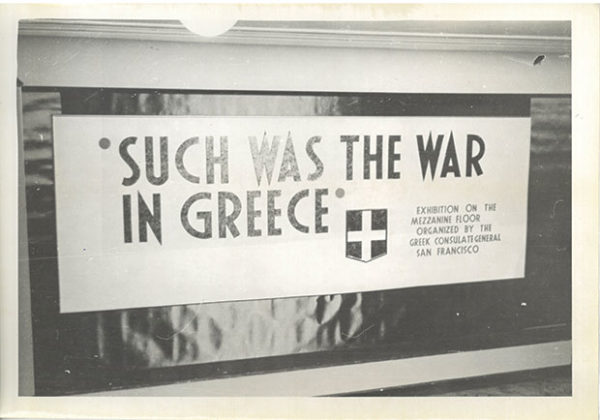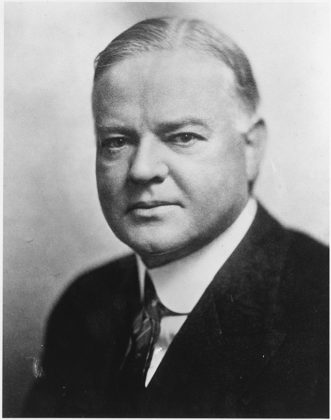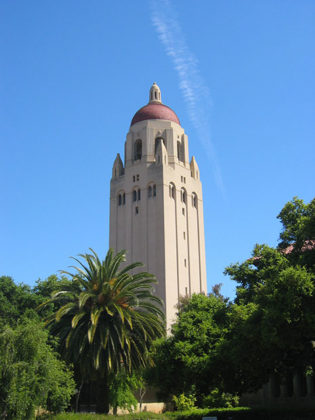The “Doxiadis” Exhibition and its American Epilogue
by Ilias Chrissochoidis*
History is Greece’s timeless currency. Without it, modern Hellenism could hardly have been granted statehood by the Great Powers two centuries ago. And because of it the Greeks are bound to live in perpetual anxiety at the intersection of East and West, North and South.
Yet history is not a fossil. Being alive, it feeds on new sources, re-evaluates old ones, changes ideological filters, and, occasionally, takes revenge on its forgers. It can also be suppressed or remain incarcerated, as was the case with the groundbreaking “Doxiadis” exhibition on Greece’s war ravages, a unique contribution in the documentation of modern era tragedies.

C. A. Doxiadis, CBS interview, June 1945 (Archive Files 28829). ©Constantinos and Emma Doxiadis Foundation
The young architect Constantinos [Konstantinos] A. Doxiadis (1913–1975) began collecting material on war damages in Greece as early as May 1941. By the time Athens was liberated, in October 1944, he had been ready to present it in a systematic way. Working under the auspices of the new Ministry for Reconstruction, he managed to integrate it into the national effort for war reparations and economic reconstruction.[i]
The resulting exhibition “Such Was the War in Greece” (1945) toured major cities of the Allied powers, culminating in San Francisco during the U.N. charter conference (1945), and dazzled visitors with its visualized statistical data.[ii]

“Such Was the War in Greece,” Basil J. Vlavianos papers, MSS 2002/09, Box 155, Folder 8, Donald & Beverly Gerth Special Collections & University Archives, University Library, California State University, Sacramento
The exhibits were then turned into a four-language album entitled The Sacrifices of Greece in the Second World War (1946), copies of which were sent to institutions abroad. Regardless of its effectiveness in securing war reparations, the album was an extraordinary publishing achievement of the Greek State. Its historical significance was recognized by its several reprints, the last one in 2014.
At the same time the Greek newspaper Kathimerini was reprinting The Sacrifices of Greece in two volumes (19, 26 January 2014), I was exploring an unusually large box at Stanford University (Hoover Institution Library and Archives, Collection Number: XX654). The library catalog identified it as “Greece. Hypourgeion Anoikodomeseos charts” and the short description read “Depicts Greece’s economic losses during World War II.”[iii] Although the album-based book Such Was the War in Greece (1947), authored by Doxiadis, exists in Hoover Institution library’s collections, no one had ever made the connection between the two.

Herbert Hoover
My research revealed that 1) the box contains maps and diagrams of the exhibition “Such Was the War in Greece” and that 2) the material was part of the personal library of former U.S. President Herbert Hoover (1874–1964).
When, where, and how Hoover acquired the maps is unknown. His relationship with Greece, however, is well documented. A member of the national committee of the Greek War Relief Association (GWRA) during the war, he visited Athens on April 16, 1946, as an envoy of President Truman,[iv] pleading for the immediate dispatch of 100 thousand tons of cereals to the country.[v] It was the same time that The Sacrifices of Greece was being printed and Doxiadis was advancing groundbreaking financial solutions for the reconstruction of the country.[vi]
A reasonable guess is that Hoover received the maps during that visit as part of honorary events, such as his award of an honorary doctorate by the University and an honorary citizenship of the City of Athens (17/4/1946).[vii] Since the album was not yet released,[viii] he might have received a copy of its contents in the form of unbound maps. In any case, the material ended up in his namesake institution at Stanford, remaining ignored for decades.

Doxiadis explains a map of the exhibition to U.S. officials, Basil J. Vlavianos papers, MSS 2002/09, Box 155, Folder 8, Donald & Beverly Gerth Special Collections & University Archives, University Library, California State University, Sacramento
The oversized cardboard sleeve contains 62 maps and diagrams printed on soft paper and measuring 13.5 by 18.5 inches as well as a printed list of damages (see below). Twenty-eight of the original exhibits, including all photos, are missing.[ix]
The classification of the maps does not follow their original numbering. For example, maps depicting the invasion of Greece by the Axis powers (nos. 10–18), of historical value by 1946, appear at the end of the sequence.
English titles are superimposed on the original Greek ones. Twelve maps and diagrams bear at their bottom inscriptions in English describing and estimating the itemized damages.[x] The amounts are identical to those in the printed list with only two exceptions.
The most glaring one concerns Greece’s merchant navy (no. 42). Whereas the list estimates its losses at $342,303,049, the inscription on the map raises them to $512,445,597! One wonders if the acquisition of American Liberty ships by Greek ship owners on extremely favorable terms[xi] was linked to the overvaluation of losses in this sector? (In 2014, Professor Kostas Kostis spoke of “excessive, at times, estimates of disasters.”[xii])
Adjusted for inflation (4/1946–1/2023)[xiii] Greece’s total war losses are estimated at $222.68 billion with the following apportionment: $161.33 (Germany), $50.67 (Italy), and $10.67 (Bulgaria).

Hoover Institution at Stanford University
The “Doxiadis” exhibition, hardly known in America, stands as a rare moment of government efficiency and patriotic responsibility in postwar Greece, offering comprehensive and reliable documentation on the most tragic period in its modern history. Alas, its international impact did not translate into the expected war reparations. Even so, the maps that have for decades been buried in the vaults of the Hoover Institution deserve full digitization and open access to the public.[xiv]
Ilias Chrissochoidis, Ph.D., is Academic staff, Stanford Continuing Studies (2023) and Research Associate, Department of Music at Stanford University.
| DEPARTMENT FOR RECONSTRUCTION | |
| LIST OF TOTAL DAMAGES SUFFERED BY GREECE
IN CONSEQUENCE OF THE WAR |
|
| Salt-Pans | $ 2.744.462 |
| Hydraulic Works | 14.889.319 |
| Ports | 14.962.645 |
| Touristical Centres | 18.543.000 |
| Machinery & Tools | 18.817.000 |
| P.T.T. | 24.158.036 |
| Schools, Churches, Museums | 25.214.947 |
| Electric Installations | 27.986.996 |
| Fisheries | 31.765.823 |
| Road Nets | 50.950.000 |
| Mining | 61.813.116 |
| Budget | 72.484.000 |
| Forests | 78.172.717 |
| Railway, Street-cars, Motorcars and motor-cycles | 142.494.098 |
| Unpaid services | 145.121.000 |
| Losses to merchant marine during neutrality | 170.142.548 |
| Plunder of goods from State Warehouses | 199.840.000 |
| Furniture & Fittings | 230.875.668 |
| Cost of Occupation Forces | 255.082.647 |
| Trade | 268.817.170 |
| Merchant Marine | 342.303.049 |
| Army, Navy & Airforce material | 469.748.000 |
| Industry | 503.246.300 |
| Loss consequent to trade relations | 527.532.083 |
| Buildings | 539.353.144 |
| Stock-breeding | 626.442.275 |
| Rural Installations & Agricultural Production | 700.299.845 |
| Pensions to war victims | 868.536.175 |
| Loss consequent to decrease in work output | 1.423.802.000 |
| Decrease in production and output | 5.837.400.000 |
| Total damages | [13.693.538.063]
13.696.068.658 |
| The following States are responsible for the following amounts: | |
| Germany for | $ 9.922.853.300 |
| Italy [for] | 3.116.383.769 |
| Bulgaria [for] | 656.831.589 |
Note: I am thankful to Mrs. Giota Pavlidou, archivist at the “Konstantinos A. Doxiadis Archive” for her assistance in the completion of this article, and to Dr. George Paganelis, Curator, Tsakopoulos Hellenic Collection (California State University, Sacramento).
*Dr. Ilias Chrissochoidis (http://www.stanford.edu/~ichriss) is a researcher at Stanford University, author, pianist and composer. He has edited Spyros P. Skouras, Memoirs (1893-1953) and has discovered dozens of historical sources on modern Greece in American archives (https://stanford.academia.edu/ILIASCHRISSOCHOIDIS/Modern-Greek-History).
[1] Lefteris Theodosis, “Victory over Chaos? Constantinos A. Doxiadis and Ekistics 1945-1975” (Ph.D. dissertation, Universitat Politècnica de Catalunya, 2015), 17–31.
[2] “Greek explains plan for reconstruction,” The New York Times, 17 July 1945, 7. For the Vienna method of visualizing statistical data, see Kostas Tsiambaos, “Isotype diagrams from Neurath to Doxiadis,” Architectural Research Quarterly 16 (2012), 49–57.
[3] https://oac.cdlib.org/findaid/ark:/13030/kt3r29r5p0/
[4] “Ο κ. Χούβερ αφίχθη εις τας Αθήνας,” Ελευθερία, 17 April 1946, 1. “Hoover urges aid to Greece at once,” The New York Times, 18 April 1946, 10.
[5] At the next stop of his tour, Cairo, the Egyptian government announced the shipment of foodstuff to Greece and India: “30,000 Tons of Corn for Greece and India,” South China Morning Post & the Hongkong Telegraph, 22 April 1946, 7. Hoover’s speeches on aiding Greece were reprinted in his book Addresses upon the American Road, 1945–1948 (New York, 1949), 267–268, 303–304.
[6] See “Ανάγκη εξευρέσεως πόρων διά το έργον της ανοικοδομήσεως: Ανακοινώσεις του κ. Δοξιάδη,” Εμπρός, 24 March 1946, 4.
[7] “Ανακοινώσεις του κ. Χούβερ διά τα επισιτιστικά ζητήματα της Ελλάδος και της Ευρώπης,” Εμπρός, 18 April 1946, 1.
[8] “printing ended in July 1946”: The Sacrifices of Greece in the Second World War (Athens, 1946), “Contents.”
[9] Nos. 5, 27, 31–32, 36, 39, 43, 47, 52, 54, 56, 58–59, 61, 68–70, 73, 75–76, 79, 80, 84, 86, 88–90.
[10] Nos. 19, 22, 25, 26, 28, 35, 37, 42, 44, 45, 57, 60.
[11] See Drew Pearson, “Greek Ship Empire Traced,” The Washington Post, 16 May 1951, Β15.
[12] See https://www.youtube.com/watch?v=VeF8Za-8upo&t=157s
[13] https://www.bls.gov/data/inflation_calculator.htm
[14] Photographs of the exhibits are so far available only through this author’s personal account at Stanford University: http://web.stanford.edu/~ichriss/GR-WWII.htm











0 comments